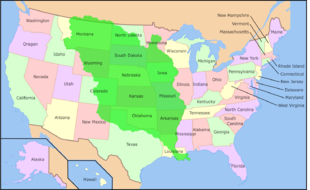Louisiana (New France)
Louisiana (also French Louisiana) was a French colony in the central area of North America from the 16th century until the 19th century. The capital was La Nouvelle-Orléans.
In 1535, French navigator Jacques Cartier sailed around Newfoundland, establishing a settlement on the Gulf of St. Lawrence and taking possession of much of Canada for France. He sailed as far as the Indian village of Stadacona, but it was not until 83 years later that the first permanent French colony of Québec (New France) was founded near it by the navigator Samuel de Champlain. Later, other such villages were founded, which became the basis of important cities such as Montreal or Trois-Rivières. In the following period, the French advanced westward from the mouth of the Saint Lawrence River to the Canadian Chain of Lakes.
When the English took possession of Hudson Bay to the north in 1668, New France saw its interests hurt. The French, in the shape of Jacques Marquette and Louis Joliet, turned southwest and reached the Mississippi River in 1673.
In 1682, Robert Cavelier de La Salle followed the Mississippi River to its mouth in the Gulf of Mexico and took possession of all the lands along the river for France. These lands were combined into one territory, which was named Louisiana in honor of the French king Louis XIV. With these territorial claims, France had drawn a bar to the further westward expansion of English territory in the south and center of the continent. Only in the north could the English advance to the Pacific Ocean.
In 1718, the city of La Nouvelle-Orléans, now New Orleans, was founded on the Mississippi River. This allowed trade flows from areas west of the Appalachians to be established across the Mississippi River system and its tributaries to Europe, and with the rapidly growing city, France also gained the practical ability to enforce territorial claims on the river in the event of conflict. French efforts to expand the colony in 1685 by establishing a settlement in Matagorda Bay into what is now Texas, claimed by Spain, ended in disaster, however.
In North America, not only the trading companies but the French and English settler peoples were now fighting each other, so that the future of North America depended on their different growth. By 1750, French settlers numbered 26,000 in Canada and just 5,200 in Louisiana, 2,000 of whom were blacks/slaves; the English, by contrast, had nearly 400,000 settlers.
In the French and Indian War (1754-1763), which was also fought for supremacy in North America and India, the French initially recorded military successes, but the mobilization of all forces enabled the English to turn the tide: in 1758 the French were driven out of the Ohio Valley, and in September they succeeded in capturing Quebec. In 1760, the entire French forces in Canada surrendered. Fearing that it would lose all its American colonies to England, France ceded Louisiana west of the Mississippi and the Isle of New Orleans to Spain in the preliminary peace of Fontainebleau on November 3, 1762. This agreement was confirmed in the Peace of Paris on February 10, 1763. The eastern territories of Louisiana fell to England, as did the colonies in India and Canada. For France, this peace agreement was a major colonial defeat and the end of the dream of a French North America.
English Louisiana went to the United States after the American War of Independence. Spain was forced by Napoleon to cede its share of Louisiana to France (Secret Treaty of San Ildefonso, October 1, 1800). When President Jefferson learned of this cession, he offered to buy the Isle of Orleans from France. To their surprise, the American diplomats who had come to France to consummate the purchase were offered all of Louisiana. This was because Napoleon, after Toussaint Louverture's expulsion of French troops from Saint Domingue, Haiti, had to fear that Louisiana would become indefensible and fall to England in the event of another war with England. The diplomats agreed to the purchase without first consulting Jefferson, who was in the United States, and the deal known as the Louisiana Purchase was completed, Louisiana going to the United States for 80 million francs ($15 million).
In 1804, the Isle of Orleans was split off from the Louisiana Territory under the name Orleans Territory. In 1812, the Orleans Territory became the 18th U.S. state under the name Louisiana. The Louisiana Territory was renamed the Missouri Territory.

The colony of Louisiana sold in the Louisiana Purchase (green)

Letter from Thomas Jefferson to US Secretary of State James Madison announcing the purchase of Louisiana from France (written in New Orleans)
See also
- French in the USA
Search within the encyclopedia